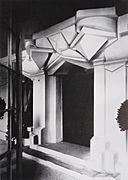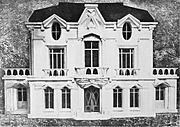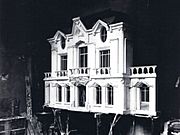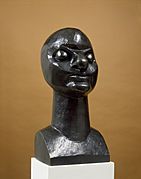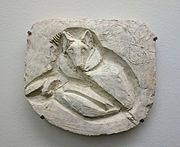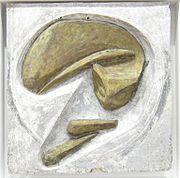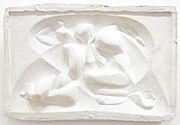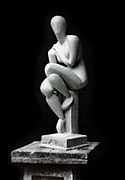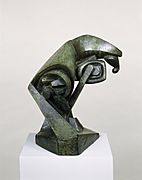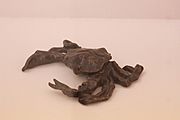Raymond Duchamp-Villon facts for kids
Quick facts for kids
Raymond Duchamp-Villon
|
|
|---|---|
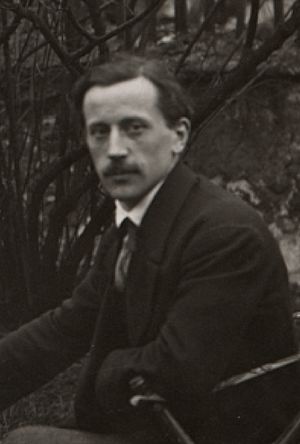
Raymond Duchamp-Villon, c.1913, photo in the Smithsonian Institution Archives of American Art
|
|
| Born |
Pierre-Maurice-Raymond Duchamp
5 November 1876 Damville, Eure, France
|
| Died | 9 October 1918 (aged 41) Cannes, France
|
| Nationality | French |
| Known for | Sculpture |
|
Notable work
|
The Large Horse (1914), La Maison Cubiste facade (1912) |
| Movement | Cubism |
Raymond Duchamp-Villon (born November 5, 1876 – died October 9, 1918) was a French sculptor. He was part of a very artistic family; four of his six siblings became famous artists. His brothers were Jacques Villon and Marcel Duchamp, and his sister was Suzanne Duchamp-Crotti.
Early Life and Art Journey
Raymond Duchamp-Villon was born Pierre-Maurice-Raymond Duchamp in Damville, a town in the Normandy region of France. His family was very creative. His grandfather was a painter and engraver.
From 1894 to 1898, Raymond lived in Montmartre, a famous art area in Paris, with his brother Jacques. He studied medicine at the Sorbonne. However, he got rheumatic fever in 1898, which made him too sick to continue his studies. This illness changed his path, and he decided to become a sculptor. He taught himself how to sculpt and quickly became very skilled.
To make sure his art was recognized as his own, and not confused with his artist brothers' work, he started using "Duchamp-Villon" on all his sculptures.
Becoming a Cubist Artist
In 1905, Raymond Duchamp-Villon had his first art show at the Salon d'Automne. He also had a show in Rouen with his brother Jacques. A few years later, in 1907, they moved to a village called Puteaux, just outside Paris. Here, the three Duchamp brothers often met with other artists, poets, and critics. This group became known as the Section d'Or.
Raymond's talent was well-known. In 1907, he was chosen to be a judge for the sculpture section of the Salon d'Automne. He also played a big part in promoting the Cubist art movement. Cubism was a new style where artists broke down objects into geometric shapes.
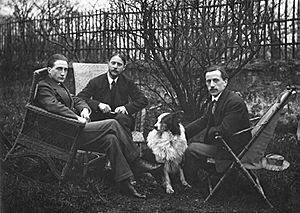
In 1911, he showed his work at the Galerie de l’Art Contemporain in Paris. The next year, his art was part of a show organized by the Duchamp brothers at the Salon de la Section d’Or. All three Duchamp brothers also showed their art at the 1913 Armory Show in New York City. This important exhibition helped introduce modern art to the United States.
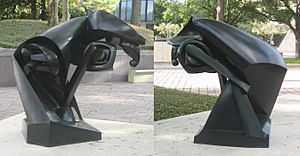
In 1913 and 1914, he took part in more exhibitions in Paris, Prague, and Berlin. During World War I, Raymond Duchamp-Villon served in the French army as a medical assistant. Even while serving, he continued to work on his most famous cubist sculpture, The Large Horse.
Later Life and Legacy
In late 1916, Raymond Duchamp-Villon became very ill with typhoid fever while serving in the army in Champagne. He was taken to a military hospital in Cannes, where he sadly passed away on October 9, 1918.
Many years later, in 1967, his brother Marcel helped organize an art show in Rouen. It was called Les Duchamp: Jacques Villon, Raymond Duchamp-Villon, Marcel Duchamp, Suzanne Duchamp. This family exhibition was later shown at the Musée National d'Art Moderne in Paris, celebrating the amazing artistic talent of the Duchamp family.
Gallery
-
1910, Torse de jeune homme (Torso of a young man), terracotta, Armory Show postcard, published 1913
Solomon R. Guggenheim Museum
New York City -
(cast 1954), Maggy (Maggy), bronze, 1912.
Solomon R. Guggenheim Museum
New York City -
ca. 1930 cast of Le cheval (The Horse), bronze and patina
Solomon R. Guggenheim Museum
New York City
See also
 In Spanish: Raymond Duchamp-Villon para niños
In Spanish: Raymond Duchamp-Villon para niños



